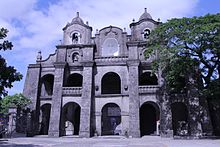Santuario del Santo Cristo
| Santuario del Santo Cristo | |
|---|---|
| Santuario del Santo Cristo Parish | |
| San Juan del Monte Church | |

West façade of the present shrine
|
|
| 14°35′54″N 121°01′50″E / 14.598333°N 121.030556°ECoordinates: 14°35′54″N 121°01′50″E / 14.598333°N 121.030556°E | |
| Location | 183 F. Blumentritt St., San Juan, Metro Manila |
| Country | Philippines |
| Denomination | Roman Catholic |
| Website | |
| History | |
| Founded | 1602 |
| Founder(s) | Dominicans |
| Dedication | Holy Cross |
| Associated people | Fr. Sebastian de Oquendo, OP |
| Architecture | |
| Functional status | Active |
| Heritage designation | Historic structure |
| Designated | 1937 |
| Style | Earthquake baroque |
| Specifications | |
| Number of spires | 2 |
| Materials | stone, cement |
| Administration | |
| Parish | Santuario del Sto. Cristo Parish |
| Archdiocese | Roman Catholic Archdiocese of Manila |
| Clergy | |
| Archbishop | Cardinal Luis Antonio Tagle |
| Priest in charge | Fr. Jesús Prol O.P. |
The Santuario del Santo Cristo, also known as the Church of San Juan del Monte is a church and convento in San Juan, Metro Manila, Philippines. The shrine was built in 1602-1604 by the Dominicans on land that was donated to the order. Both the church and convento were burnt and destroyed during the Chinese insurrection of 1639, and later rebuilt in 1641. It was again destroyed in July 1763 as Britain briefly occupied Manila during the Seven Years' War. The current church and convento were built in 1774, and used as a shelter by Katipuneros during the 1898 Philippine Revolution against the Spanish Empire. It has since been renovated many times until the 1990s.
The shrine is the seat of the Cofradia del Santísimo Cristo de San Juan del Monte ("Confraternity of the Holy Christ of Saint John of the Mountain"), which received papal approval on March 4, 1648.
The Dominicans arrived in the Spanish East Indies in 1587 and had founded the Santo Domingo Convent in Spanish Manila (now known as Intramuros). Fifteen years after their arrival, the Dominicans went to the hill country east of Manila in what is now San Juan, and found clusters of small nipa huts. The area was the property of a certain Spaniard named Captain Julian de Cuenca, who had been granted an encomienda along the banks of the San Juan River where cattle were bred and raised.
The heavy work and hot climate were taking their toll on some of the ageing friars, who had been in the colony for several years already. While the Order's vow of poverty stood in contrast with the concept of a convalescent and retirement home for Dominicans working in Manila and in the provinces, it was decided that it would be in order under three conditions:
It so happened that Captain Cuenca had heard about the Dominicans' plan; he lived in Manila and before that Mexico, where he had befriended some of the Order's members. He and his wife thought it the right time to show their family's gratitude to the Dominicans, and so they offered an nearly three-hectare plot of wooded land in his hacienda along the San Juan River. The property was at a higher elevation than Manila and close to the city ("one legua", or five kilometres to the east). It was also easily accessible by banca (outrigger canoe): up the River Pasig, then into the San Juan River and finally landing at the embarcadero Captain Cuenca had built at the confluence of the San Juan and Maytunas Creek.
...
Wikipedia
